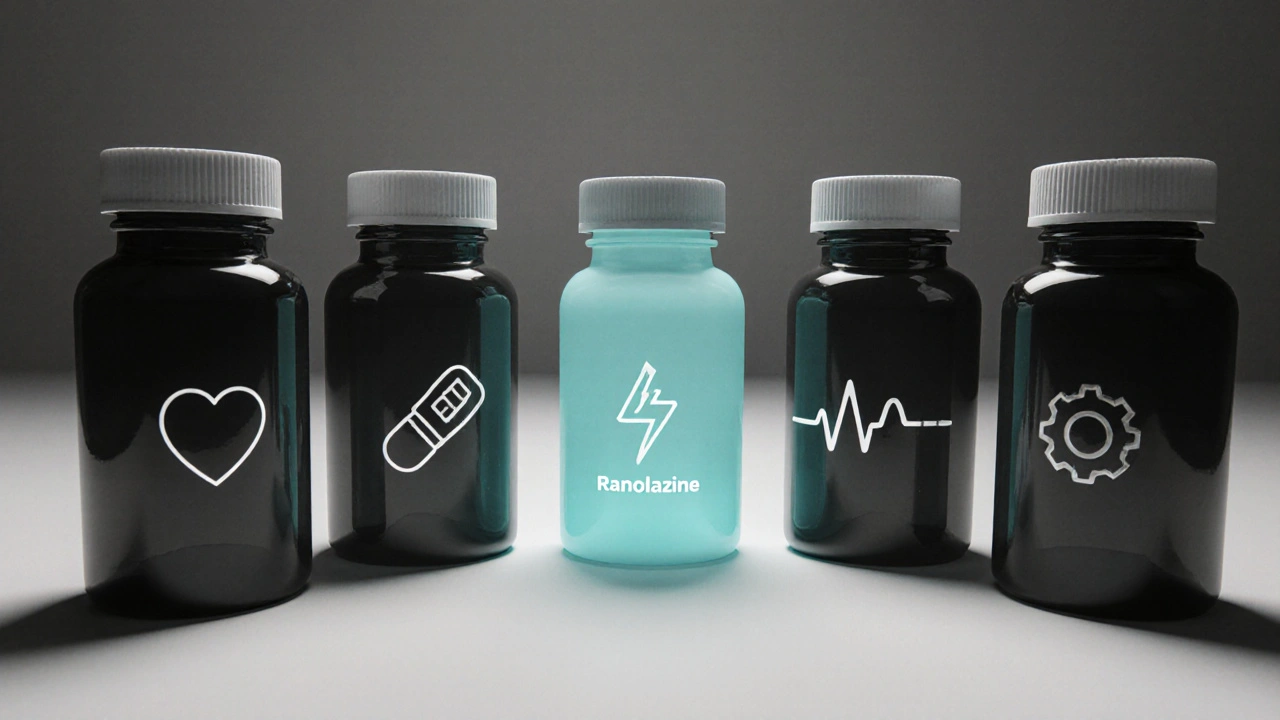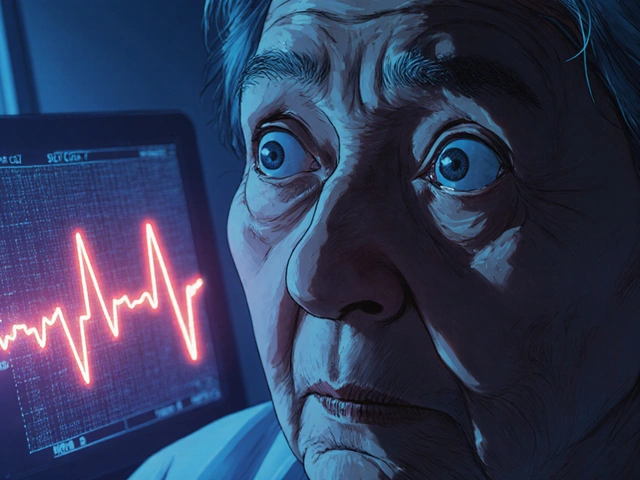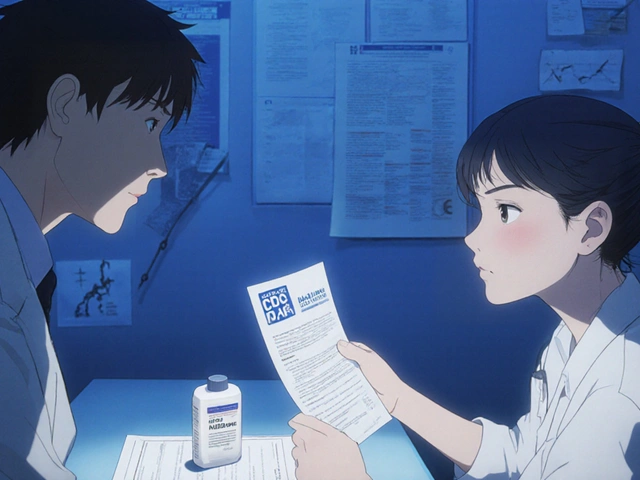
Anti-Anginal Drug Cost Comparison Calculator
Cost Comparison Tool
This tool helps you understand the monthly costs of different anti-anginal medications based on U.S. pricing data (2025). Compare brand versus generic options to make informed decisions with your healthcare provider.
Cost Comparison Results
When you or a loved one wrestles with chronic stable angina, picking the right medication can feel like navigating a maze. Ranolazine has been marketed under the name Ranexa for years, promising relief without dropping blood pressure or heart rate. But it’s not the only player in the anti‑anginal arena. This guide breaks down how Ranolazine stacks up against the most common alternatives, helping you weigh efficacy, side‑effects, dosing, and cost before you or your doctor decide what’s best.
Key Takeaways
- Ranolazine works by reducing the heart’s oxygen demand without major effects on blood pressure or heart rate.
- Beta‑blockers and calcium‑channel blockers remain first‑line, but may cause fatigue, dizziness, or low blood pressure.
- Nitrates provide quick relief but often lead to tolerance, requiring drug‑free intervals.
- Ivabradine and trimetazidine are useful add‑on options, especially when standard therapies fall short.
- Cost varies widely; generic Ranolazine is cheaper than brand Ranexa, yet still pricier than many generics.
Below you’ll find a side‑by‑side look at each drug class, followed by practical tips for choosing the right regimen.
Understanding Ranolazine (Ranexa)
Ranolazine is an oral anti‑anginal agent approved by the FDA in 2006. It belongs to a unique class that targets the late sodium current in cardiac cells, thereby improving myocardial relaxation and lowering oxygen consumption. Unlike beta‑blockers or calcium‑channel blockers, it does not significantly alter heart rate or systemic blood pressure, making it a popular add‑on for patients who cannot tolerate those effects.
Typical dosing starts at 500mg twice daily, titrated up to 1000mg twice daily based on response and tolerability. Common side‑effects include dizziness, constipation, and nausea; rare but serious concerns involve QT‑interval prolongation, so periodic ECG monitoring is advised.
Beta‑Blockers: The Classic First‑Line
Metoprolol, a cardio‑selective beta‑blocker, reduces heart rate and contractility, thus decreasing myocardial oxygen demand. It has been the backbone of angina therapy for decades.
Standard dosing ranges from 25mg to 200mg daily, split into one or two doses. Benefits include mortality reduction in post‑MI patients, but side‑effects such as fatigue, cold extremities, and bronchospasm in asthmatics can limit its use.
Calcium‑Channel Blockers: Vasodilators and Inotropes
Amlodipine is a dihydropyridine calcium‑channel blocker that primarily dilates peripheral vessels, easing the heart’s workload. It’s especially handy when blood pressure control is also needed.
Dosage typically starts at 5mg daily, with a maximum of 10mg. While effective, it may cause peripheral edema and a reflex increase in heart rate, which can be uncomfortable for some patients.

Nitrates: Quick Relief with a Tolerance Twist
Isosorbide mononitrate releases nitric oxide, causing vasodilation of veins and arteries. This lowers preload and, to a lesser extent, afterload.
Extended‑release formulations are taken once daily (30-60mg). Patients often experience headache and facial flushing, and tachyphylaxis can develop after a few weeks, necessitating a “nitrate‑free interval” each day.
Ivabradine: Targeted Heart‑Rate Reduction
Ivabradine selectively inhibits the funny current (If) in the sinoatrial node, slowing heart rate without affecting contractility or blood pressure. It’s approved for patients with stable angina who remain symptomatic despite beta‑blocker therapy.
Dosage begins at 5mg twice daily, adjusted up to 7.5mg twice daily. Visual disturbances (phosphenes) and bradycardia are the main adverse effects to watch.
Trimetazidine: Metabolic Modulator
Trimetazidine shifts cardiac metabolism from fatty‑acid oxidation toward glucose utilization, which requires less oxygen for the same ATP production.
Typical dosing is 20mg three times daily. It is generally well‑tolerated, but rare cases of Parkinson‑like symptoms have been reported, prompting cautious use in the elderly.

Side‑Effect Profile Comparison
| Drug/Class | Most Common Side‑Effects | Serious Risks |
|---|---|---|
| Ranolazine (Ranexa) | Dizziness, constipation, nausea | QT prolongation |
| Beta‑blocker (e.g., Metoprolol) | Fatigue, cold extremities, insomnia | Bronchospasm, severe bradycardia |
| Calcium‑channel blocker (Amlodipine) | Peripheral edema, flushing | Hypotension, reflex tachycardia |
| Nitrate (Isosorbide mononitrate) | Headache, dizziness | Severe hypotension, tolerance |
| Ivabradine | Visual phosphenes, bradycardia | Excessive heart‑rate slowing |
| Trimetazidine | Gastrointestinal upset | Movement disorders (rare) |
Cost and Accessibility Snapshot
Cost is a decisive factor for many patients. Below is an approximate monthly cost for a typical dose in the United States (2025 data). Prices are for brand or generic forms where available.
| Drug | Brand Price | Generic Price |
|---|---|---|
| Ranolazine (Ranexa) | $300 | $120 |
| Metoprolol | $25 | $12 |
| Amlodipine | $30 | $10 |
| Isosorbide mononitrate | $40 | $15 |
| Ivabradine | $200 | $180 (no generic) |
| Trimetazidine | $250 | $220 (limited generic) |
Choosing the Right Therapy: Practical Decision Guide
- First‑line choice: If you haven’t tried any anti‑anginals, beta‑blockers or calcium‑channel blockers are usually recommended because of their proven mortality benefit and cost‑effectiveness.
- When blood pressure is low: Ranolazine shines here, as it spares you from further drops in pressure.
- Frequent breakthrough pain: Short‑acting nitrates can be used for episodic relief, but plan a nitrate‑free interval to avoid tolerance.
- Persistent symptoms despite two drugs: Adding Ranolazine or Ivabradine may improve exercise tolerance without extra blood‑pressure effects.
- Concern about side‑effects: Trimetazidine offers a metabolic approach with a low incidence of systemic symptoms.
Always discuss these options with a cardiologist, who can tailor dosing based on renal function, drug interactions (especially with CYP3A4 inhibitors for Ranolazine), and your overall cardiovascular risk profile.
Frequently Asked Questions
Can Ranolazine be used alone for chronic angina?
Yes, Ranolazine can be prescribed as monotherapy, especially when patients cannot tolerate beta‑blockers or calcium‑channel blockers. However, guidelines often recommend it after at least one first‑line agent has been tried.
What drug interactions should I watch for with Ranolazine?
Ranolazine is metabolized by CYP3A4. Strong inhibitors like ketoconazole, clarithromycin, or certain HIV protease inhibitors can raise its plasma levels, increasing the risk of QT prolongation. Dose reductions are often required.
Is Ranolazine safe for patients with kidney disease?
Dose adjustments are recommended for creatinine clearance below 30mL/min. The usual practice is to start at 500mg twice daily and monitor for side‑effects.
How quickly does Ranolazine start working?
Clinical trials show noticeable improvement in exercise tolerance within 1‑2 weeks, with maximal benefit reached after 4‑6 weeks of steady dosing.
Are there any lifestyle changes that enhance the effect of anti‑anginal meds?
Absolutely. Regular aerobic exercise, a heart‑healthy diet, smoking cessation, and stress management can all improve medication efficacy and reduce the frequency of angina attacks.
In the end, there’s no one‑size‑fits‑all answer. Ranolazine offers a valuable option when you need angina relief without further blood‑pressure drops, but beta‑blockers, calcium‑channel blockers, nitrates, ivabradine, and trimetazidine each have unique strengths. By matching drug characteristics to your personal health profile and budget, you can find the combination that lets you stay active and pain‑free.
Write a comment
Your email address will not be published.






10 Comments
Understanding how each anti‑anginal works can feel overwhelming, but breaking it down into simple concepts makes a big difference.
Think of the heart like a car engine: you can either reduce the fuel demand or improve the efficiency of the engine itself.
Ranolazine fits the latter category by easing the heart’s workload without dropping blood pressure, which is helpful for patients who already have low pressures.
Keep focusing on what matches your personal health goals and discuss the options with your cardiologist.
Great summary! 🙌 Your breakdown of each drug class is crystal clear, and the side‑effect table is super handy!! I love how you highlighted the cost differences-knowing the price tag really helps when making decisions!! Keep up the awesome work!! 😊
While the comparative analysis is comprehensive, it would be prudent to emphasize that guideline‑directed therapy remains paramount. The authors might consider integrating recent ESC recommendations to reinforce evidence‑based practice.
In the grand theater of cardiovascular pharmacology, Ranolazine takes the stage with a flair that few drugs can match.
Its mechanism, targeting the late sodium current, is as elegant as a perfectly composed raga that soothes a restless soul.
Unlike the pedestrian beta‑blockers that merely blunt the heart's tempo, Ranolazine refines the cellular dance without imposing a heavy hand on blood pressure.
This subtlety is especially prized in our subcontinental population, where many patients already battle low vascular tone.
Moreover, the drug's oral administration sidesteps the invasive aura that surrounds many intravenous agents, making it a dignified choice for everyday warriors.
Cost considerations, though not negligible, are increasingly mitigated by the availability of generic formulations that honour the patient’s purse.
The modest side‑effect profile-chiefly dizziness and mild gastrointestinal upset-poses far less of a burden than the edema induced by certain calcium‑channel blockers.
One must, however, remain vigilant for QT‑interval prolongation, a reminder that even the most refined agents demand respect.
In clinical practice, I have observed that patients transitioning from nitrate dependence to Ranolazine report a resurgence of activity, akin to a phoenix rising from the ash of tolerance.
Such anecdotes underscore the drug's capacity to restore quality of life without the shackles of frequent dosing adjustments.
From a pharmacokinetic perspective, the reliance on CYP3A4 metabolism invites a dialogue with prescribers about potential drug interactions.
Avoiding strong inhibitors like ketoconazole ensures that Ranolazine retains its therapeutic window without courting danger.
In the larger schema of anti‑anginal therapy, Ranolazine occupies a niche that bridges the gap between classic agents and emerging metabolic modulators.
It is, therefore, a testament to modern medicine that we can offer patients a choice that honors both efficacy and tolerability.
Ultimately, the decision to employ Ranolazine should be guided by a holistic assessment of the individual's hemodynamics, comorbidities, and personal aspirations.
I appreciate the thorough perspective you provided.
When weighing options, consider both clinical effectiveness and the patient's lifestyle; a balanced approach often yields the best long‑term outcomes.
Oh sure, because everyone has time to read a 15‑sentence dissertation before picking a pill.
It's helpful to remember that lifestyle modifications-such as regular walking, a low‑sodium diet, and stress reduction-can amplify the benefits of any anti‑anginal regimen.
Idk why u even need all that stuff!!! It’s just meds, pick one and move on!!!
I've been in the same boat trying to understand which medication fits best, and I know how confusing the options can appear.
It really helps to write down the pros and cons of each drug, especially how they affect blood pressure and daily activities.
Talking openly with your doctor about any side‑effects you notice can prevent bigger issues down the line.
Remember, the goal is to keep you active and pain‑free, not to add extra stress.